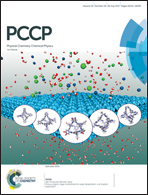Aromaticity and antiaromaticity of substituted fulvene derivatives: perspectives from the information-theoretic approach in density functional reactivity theory
Abstract
Even though the concept of aromaticity and antiaromaticity is extremely important and widely used, there still exist lots of controversies in the literature, which are believed to be originated from the fact that there are so many aromatic types discovered and at the same time there are many aromaticity indexes proposed. In this work, using seven series of substituted fulvene derivatives as an example and with the information-theoretic approach in density functional reactivity theory, we examine these concepts from a different perspective. We investigate the changing patterns of Shannon entropy, Fisher information, Ghosh–Berkowitz–Parr entropy, information gain, Onicescu information energy, and relative Renyi entropy on the ring carbon atoms of these systems. Meanwhile, we also consider variation trends of four representative kinds of aromaticity indexes such as FLU, HOMA, ASE and NICS. Statistical analyses among these quantities show that with the same ring structure of the derivatives, both information-theoretic quantities and aromaticity indexes obey the same changing pattern, which are valid across all seven systems studied. However, cross correlations between these two sets of quantities yield two completely opposite patterns. These ring-structure dependent correlations are in good agreement with Hückel's 4n + 2 rule of aromaticity and 4n rule of antiaromaticity. Our results should provide a novel and complementary viewpoint on how aromaticity and antiaromaticity should be appreciated and categorized. More studies are in progress to further our understanding about the matter.



 Please wait while we load your content...
Please wait while we load your content...